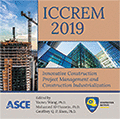International Conference on Construction and Real Estate Management 2019
The Impact of Land Intensive Use on Urban Development Quality in Mountain City: A Case Study of Chongqing, China
Publication: ICCREM 2019: Innovative Construction Project Management and Construction Industrialization
ABSTRACT
The contradiction between the construction land shortage and the urban development of the mountain city determines the inevitability of land intensive use (LIU). As a typical mountain city, the rational use of land in Chongqing is of typical significance for the coordination of land utilization and urban development in other mountainous cities. This paper employed Chongqing's land use and urban development data from 1998 to 2016, adopted econometric models to study the impact of LIU on Chongqing’s development quality. The results showed that: (1) the LIU level and urban development quality (UDQ) in Chongqing have been improved since 1998, and the growth rate of UDQ is 8.93 times that of LIU; (2) the impact of LIU on the UDQ is negative in the short term, while the long-term increase in LIU of 1% will promote the quality of urban development by 1.54%; (3) 55.80% of the variance in UDQ is explained by LIU, exceeding its own impact. Therefore, the government should pay attention to the role of LIU in the development of mountainous cities, adopt long-term strategies, fully exploit the potentialities of stock land, and protect natural landscapes of mountain cities.
Get full access to this article
View all available purchase options and get full access to this chapter.
REFERENCE
Burton, E. (2000). “The Compact City: Just or Just Compact? A Preliminary Analysis.” Urban Studies, 37(11), 1969-2006.
Chongqing Municipal People's Government (CQMPG). (2008). Opinions of the Chongqing Municipal People's Government on Promoting Economical and Intensive Use of Land, Chongqing, China. (in Chinese).
Chongqing Statistics Bureau (CQSB). (1999-2017). Chongqing Statistical Yearbook, Chongqing, China. (in Chinese).
Chuai, X.W., Huang, X.J., Li, L., Wang, W.J., Peng, J.W. and Zhao, R.Q. (2013). “Land use structure optimization based on carbon storage in several regional terrestrial ecosystems across China.” Environmental Science and Policy, (25), 50-61.
Garreau, J. (1992). Edge city: life on the new frontier, Doubleday, New York.
Geller, A.L. (2003). “Smart growth: a prescription for livable cities.” American Journal of Public Health, 93(9), 1410-1415.
Gong, J.Z., Chen, W.L., Liu, Y.S. and Wang, J.Y. (2014). “The intensity change of urban development land: Implications for the city master plan of Guangzhou, China.” Land Use Policy, (40), 91-100.
Huang, L., Wu, J.G. and Yan, L.J. (2015). “Defining and measuring urban sustainability: a review of indicators.” Landscape Ecology, 30(7), 1175-1193.
Hui, E.C.M., Wu, Y.Z., Deng, L.J. and Zheng, B.B. (2015). “Analysis on coupling relationship of urban scale and intensive use of land in China.” Cities, (42), 63-69.
Kanianska, R., Kizeková, M., Nováček, J. and Zeman, M. (2014). “Land-use and land-cover changes in rural areas during different political systems: a case study of Slovakia from 1782 to 2006.” Land Use Policy, 36(1), 554-566.
Kerselaers, E., Rogge, E., Vanempten, E., Lauwers, L. and Huylenbroeck, G.V. (2013). “Changing land use in the countryside: stakeholders’ perception of the ongoing rural planning processes in Flanders.” Land Use Policy, 32, 197-206.
Lambin, E.F. and Meyfroidt, P. (2010). “Land use transitions: socio-ecological feedback versus socio-economic change.” Land Use Policy, 27(2), 108-118.
Li, C.F., Wu, Q.H. and Zhang, L.C. (2011). “Spatial difference between land intensive use and economic development: case of the Yangtze River delta.” Economic Geography, (2), 120-125. (in Chinese).
Li, Y.H. and Zhang, Q. (2013). “Human-environment interactions in China: evidence of land-use change in Beijing-Tianjin-Hebei Metropolitan Region.” Human Ecology Review, 20(1), 26-35.
Ni, J.P., Shao, J.A. and Wei, C.F. (2011). “Land-use balances over the recent 10-year and their future scenarios in Chongqing.” Resources Science, 33(8), 1591-1599. (in Chinese).
Smith, N. (2002). “New globalism, new urbanism: gentrification as global urban strategy.” Antipode, 34(3), 427-450.
Talen, E. (1999). “Sense of community and neighborhood form: an assessment of the Social doctrine of new urbanism.” Urban Studies, 36(8), 1361-1379.
Tanguay, G.A., Rajaonson, J., Lefebvre, J.F. and Lanoie, P. (2010). “Measuring the sustainability of cities: an analysis of the use of local indicators.” Ecological Indicators, 10(2), 407-418.
United Nations Department of Economic and Social Affairs (UNDESA). (2001). Indicators of Sustainable Development: Guidelines and Methodologies, United Nations.
Weng, L.Y., Pu, L.J., Wen, J.Q. and Zhu, M. (2010). “Cointegration and causality between urban land intensive utilization and economic growth: a case study of Wuxi, Jiangsu.” Geography and Geo-Information Science, 26(2), 72-75. (in Chinese).
Wu, C.Y., Wei, Y.D., Huang, X.J. and Chen, B.W. (2017). “Economic transition, spatial development and urban land use efficiency in the Yangtze River Delta, China.” Habitat International, (63), 67-78.
Zhao, D. and Hu, Y.C. (2016). “Quantitative study of the interaction between intensive land use and urbanization in three urban agglomerations of China.” Geographical Research, 35(11), 2105-2115. (in Chinese).
Zheng, H.W., Chou, J.L. and Liu, Y.Z. (2013). “Econometric analysis of the relationship between urban land intensive utilization and urbanization in Jiangsu Province.” Resources and Environment in the Yangtze Basin, 22(8), 1019-1026. (in Chinese).
Zhu, X., Cheng, J., Wang, J. and Li, Y. (2007). “Research progress on the evaluation of urban land intensive use in China in the last decade.” Modern Urban Research, (7), 69-75. (in Chinese).
Information & Authors
Information
Published In
ICCREM 2019: Innovative Construction Project Management and Construction Industrialization
Pages: 885 - 896
Editors: Yaowu Wang, Ph.D., Harbin Institute of Technology, Mohamed Al-Hussein, Ph.D., University of Alberta, and Geoffrey Q. P. Shen, Ph.D., Hong Kong Polytechnic University
ISBN (Online): 978-0-7844-8230-8
Copyright
© 2019 American Society of Civil Engineers.
History
Published online: Aug 29, 2019
Authors
Metrics & Citations
Metrics
Citations
Download citation
If you have the appropriate software installed, you can download article citation data to the citation manager of your choice. Simply select your manager software from the list below and click Download.
